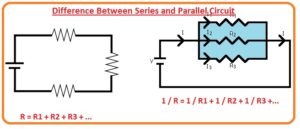 Hello guys, I hope you all are doing great. In today’s tutorial, we will discuss the Difference Between Series and Parallel Circuit. The basic difference among series and the parallel circuits is the direction with which components are connected in the circuit. In series, a combination element is attached with each other in a cascaded away like the first point of one component attached with the second point or tail of other elements.
Hello guys, I hope you all are doing great. In today’s tutorial, we will discuss the Difference Between Series and Parallel Circuit. The basic difference among series and the parallel circuits is the direction with which components are connected in the circuit. In series, a combination element is attached with each other in a cascaded away like the first point of one component attached with the second point or tail of other elements.
But in parallel configuration components are connected in such way their head join at fist point and tail at other points. In today’s post, we will have a detailed look at the series and parallel circuits and find their differences. So let’s get started with Difference Between Series and Parallel Circuit.
Difference Between Series and Parallel Circuit
Series Circuit
- In a series configuration, components of circuits are attached in a sequence with each other.
- The current flowing all the components is similar in series combination.
- Its equation is R=R1+R2+R3+—Rn
- the total resistance is the sum of all resistance in circuitry.
- If there is any fault that occurs in one component of the circuit the flow of current or operation of the complete circuit will disturb.
- The troubleshooting of this configuration is difficult.
- The voltage is equal to the summation of all volts in circuitry
- The value of voltage is different at all components present in the circuit.
- There is one path exits in the series circuit for the flow of current.
- The equivalent resistance of the series circuit is larger than the largest value of resistance connected.
- Series circuits used in batteries.
- It used for lighting purposes.
Parallel Circuit
- In parallel combination, the elements of circuits are linked in such a way that their heads at connecting at one point and tail at other points.
- The value of the current flowing through every component is different.
- Rt=1/R1+1/R2+1/R3—-1/Rn
- Parallel resistance used to define the circulatory system
- Series resistance is used for blood vessels configuration
- The voltage across every component connected in the parallel configuration is the same..
- The value of equivalent resistance for the parallel combination is less than the resistance connected in the circuit
- If there is any fault that occurs in one component of the circuit the flow of current or operation of the complete circuit will disturb.
- The troubleshooting of this configuration is difficult.
That is a detailed post about the difference between a series circuit and a parallel circuit. I tried my level best to make simple for you if you have any query ask in comments. See you in next post.







